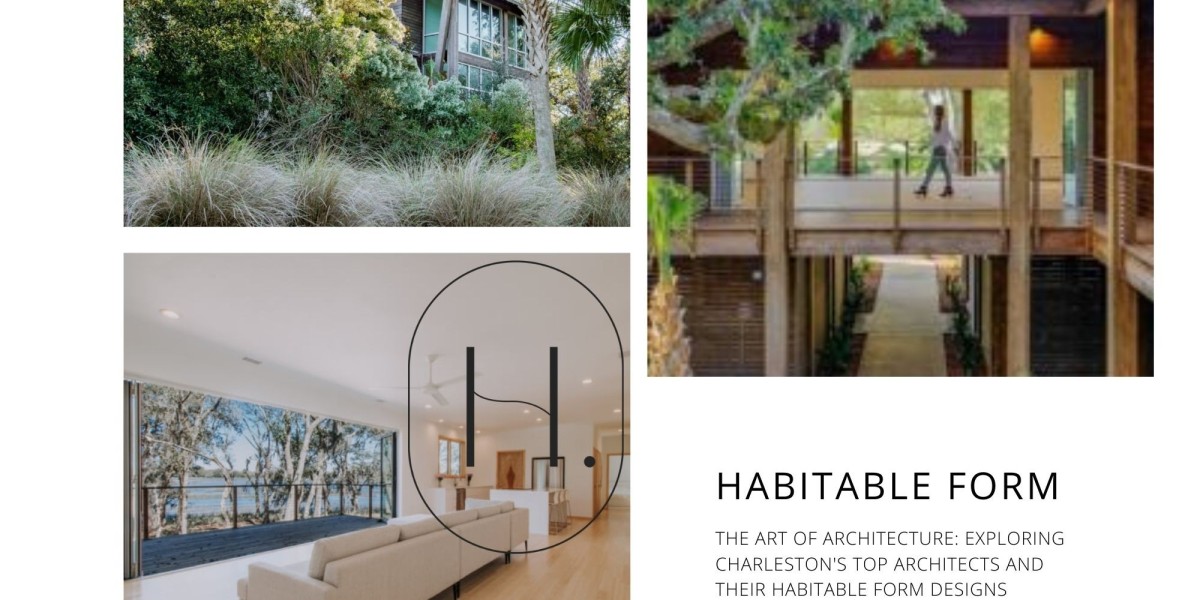Welcome to the world of architectural marvels in Charleston, where the art of design meets the essence of habitation. Charleston, renowned for its historical charm and vibrant culture, boasts a rich tapestry of architectural wonders that have stood the test of time. In this captivating exploration, we delve into the world of Charleston Architects and their masterful creations, unveiling the secrets behind their Habitable Form designs. From awe-inspiring antebellum mansions to contemporary eco-friendly structures, each architect's unique vision comes to life, seamlessly blending functionality and beauty. Join us as we unravel the stories behind these architectural gems, showcasing the innovation, skill, and passion that have shaped Charleston's urban landscape. Whether you're an architectural enthusiast, a resident, or a visitor, prepare to be captivated by the harmonious fusion of history, culture, and design that awaits you in Charleston's architectural realm.
The History of Architecture in Charleston
Charleston's architectural heritage is deeply rooted in its history. As one of the oldest cities in the United States, it has witnessed the evolution of architectural styles over the centuries. The city's architectural journey began in the 17th century when English settlers established the first permanent European settlement in Carolina. Georgian architecture, characterized by symmetrical facades and classical motifs, dominated the early years of Charleston's architectural landscape. The city's prosperity during the 18th and 19th centuries saw the rise of neoclassical and Greek Revival styles, influenced by the ideals of the Enlightenment and the elegance of ancient Greece. These architectural styles can still be seen in iconic landmarks such as the Nathaniel Russell House and the Aiken-Rhett House.
During the antebellum period, Charleston experienced a surge in wealth and population, leading to the construction of grand mansions and townhouses. The Italianate and Gothic Revival styles gained popularity, showcasing intricate details and ornate facades. The Calhoun Mansion, with its opulent interiors and breathtaking architecture, stands as a testament to this era of prosperity. However, the devastating impact of the Civil War and the subsequent Reconstruction period brought about a shift in architectural preferences. The Victorian era ushered in a mix of styles, including Queen Anne, Second Empire, and Eastlake, characterized by their elaborate ornamentation and eclectic designs.
In the early 20th century, Charleston's architectural scene experienced a revival of interest in its colonial past. The preservation movement gained momentum, leading to the establishment of the Historic Charleston Foundation in 1947. The foundation played a crucial role in promoting historic preservation and inspiring a renewed appreciation for Charleston's architectural treasures. Today, Charleston's architectural landscape is a captivating blend of history and modernity, with architectural styles ranging from colonial and antebellum to contemporary and sustainable.
Top Architects in Charleston and Their Notable Projects
Charleston is home to a talented community of architects who have left their mark on the city's urban fabric. These architects bring a unique blend of creativity, craftsmanship, and innovation to their projects, resulting in architectural masterpieces that capture the essence of Charleston's charm. Let's explore some of the top architects in Charleston and their notable projects.
Robert Mills: Known as the first architect born and trained in the United States, Robert Mills played a significant role in shaping Charleston's architectural landscape during the early 19th century. His most notable project in Charleston is the Fireproof Building, which was the first fireproof structure built in the United States. This impressive architectural feat showcases Mills' expertise in designing functional and aesthetically pleasing buildings.
Eugene C. Tisdale: As a prominent architect in Charleston during the late 19th and early 20th centuries, Eugene C. Tisdale left an indelible mark on the city's architectural heritage. One of his notable projects is the South Carolina State Arsenal, a stunning example of Gothic Revival architecture. Tisdale's meticulous attention to detail and his ability to blend historical influences with contemporary design elements are evident in his works.
Glenn Keyes: With a career spanning over five decades, Glenn Keyes is a renowned architect known for his modernist approach to design. His notable projects include the Charleston County Public Library and the Charleston City Hall. Keyes' designs embrace simplicity, functionality, and sustainability, reflecting the evolving needs of the city while respecting its rich architectural history.
Whitney Powers: A leading figure in sustainable design, Whitney Powers has made significant contributions to Charleston's architectural scene. Her notable projects include the design of the Clemson University School of Architecture's Charleston Center, which exemplifies her commitment to environmentally conscious design. Powers' innovative use of sustainable materials and energy-efficient technologies sets a new standard for architecture in Charleston.
These are just a few of the many talented architects who have shaped Charleston's architectural landscape. Each architect brings their unique perspective and expertise to their projects, resulting in a diverse and captivating urban environment.
Exploring the Unique Architectural Styles in Charleston
Charleston's architectural styles are as diverse as its rich history and culture. The city's architectural fabric is a tapestry of influences, ranging from colonial and antebellum to modern and contemporary. Let's explore some of the unique architectural styles that define Charleston's urban landscape.
Colonial Architecture: The colonial period laid the foundation for Charleston's architectural legacy. The Georgian style, characterized by symmetrical facades, brick construction, and classical details, dominated the early years. The Heyward-Washington House, built in the Georgian style, is a prime example of Charleston's colonial architecture.
Antebellum Architecture: The antebellum period witnessed a surge in wealth and a flourishing architectural scene. Greek Revival and Italianate styles gained popularity, reflecting the elegance and opulence of the era. The Aiken-Rhett House, with its grand portico and ornate interiors, showcases the magnificence of antebellum architecture in Charleston.
Victorian Architecture: The Victorian era brought a mix of architectural styles to Charleston. Queen Anne, Second Empire, and Eastlake styles became prominent, characterized by their intricate ornamentation and eclectic designs. The William Aiken House, with its colorful facade and ornate details, is a stunning example of Victorian architecture in Charleston.
Modern and Contemporary Architecture: Charleston's architectural scene has evolved to embrace modern and contemporary design. Architects like Glenn Keyes and Whitney Powers have brought innovative and sustainable approaches to their projects. The Charleston County Public Library, with its sleek lines and energy-efficient features, exemplifies the city's embrace of modern architecture.
The diverse architectural styles in Charleston reflect the city's rich history and the evolving tastes and preferences of its residents. From the grandeur of the antebellum mansions to the sleek lines of contemporary structures, Charleston's architectural landscape is a testament to the city's vibrant culture and artistic spirit.
The Role of Sustainable Design in Charleston's Architecture
In recent years, there has been a growing emphasis on sustainable design in Charleston's architectural scene. As a city with a deep appreciation for its history and natural surroundings, Charleston recognizes the importance of preserving its architectural heritage while embracing environmentally conscious practices. Sustainable design principles have become integral to the city's urban planning and architectural projects.
One of the key aspects of sustainable design in Charleston is the use of environmentally friendly materials. Architects are increasingly incorporating locally sourced and recycled materials into their projects, reducing the carbon footprint associated with construction. Additionally, the use of renewable energy sources, such as solar panels and geothermal heating and cooling systems, has gained popularity in Charleston's architectural community.
Another important aspect of sustainable design in Charleston is the integration of green spaces and sustainable landscaping. Architects are incorporating rooftop gardens, vertical gardens, and green facades into their designs, promoting biodiversity and reducing the heat island effect. These green spaces not only enhance the aesthetic appeal of the buildings but also contribute to improved air quality and a healthier urban environment.
Water conservation is also a key consideration in Charleston's sustainable design practices. Architects are implementing rainwater harvesting systems, graywater recycling, and low-flow fixtures to reduce water consumption. Additionally, the incorporation of permeable paving and stormwater management techniques helps mitigate the impact of heavy rainfall and reduces strain on the city's drainage systems.
The adoption of sustainable design principles in Charleston's architecture is not only driven by environmental concerns but also by economic and social factors. Sustainable buildings are more energy-efficient, resulting in reduced utility costs for residents and businesses. Moreover, these buildings contribute to the overall well-being of the community by providing healthier and more comfortable living and working spaces.
Charleston's commitment to sustainable design is evident in projects such as the Clemson University School of Architecture's Charleston Center, designed by Whitney Powers. This LEED-certified building showcases the integration of sustainable technologies and design strategies, setting an example for future architectural endeavors in the city.
The Process of Designing a Habitable Form
Designing a habitable form is a complex and multifaceted process that requires careful consideration of various factors, including functionality, aesthetics, and sustainability. Architects in Charleston follow a systematic approach to create spaces that are not only visually appealing but also meet the needs and aspirations of their clients.
The first step in designing a habitable form is understanding the client's requirements and objectives. Architects engage in thorough discussions and consultations to gather information about the desired functionality, spatial requirements, and aesthetic preferences. This helps architects develop a clear vision and establish a design brief for the project.
Once the design brief is established, architects conduct site analysis to understand the context and constraints of the project. Factors such as site topography, orientation, climate, and existing infrastructure are taken into consideration during this phase. Site visits and surveys provide architects with valuable insights that inform the design process.
The next step is conceptual design, where architects explore different design options and develop initial sketches and diagrams. This phase involves brainstorming ideas, experimenting with spatial arrangements, and exploring different architectural styles. Architects use their creativity and expertise to create designs that address the client's requirements and respond to the site context.
After the conceptual design phase, architects proceed to the detailed design stage. This involves refining the design, developing detailed drawings, and selecting materials and finishes. Architects collaborate with engineers, consultants, and contractors to ensure that the design is structurally sound and meets all regulatory requirements. Sustainability considerations, such as energy efficiency and water conservation, are integrated into the design process.
Once the design is finalized, architects prepare construction documents, including detailed drawings and specifications. These documents serve as a guide for the construction team and provide a comprehensive overview of the project. Architects collaborate closely with contractors during the construction phase, ensuring that the design intent is realized and any unforeseen issues are addressed.
Throughout the entire design process, architects engage in regular communication and collaboration with the client, consultants, and construction team. This ensures that the project stays on track and that any changes or modifications are incorporated seamlessly. Architects also conduct regular site visits and inspections to monitor the progress of the construction and ensure that the design intent is maintained.
Designing a habitable form is a dynamic and iterative process that requires a balance of technical expertise, creativity, and effective communication. Architects in Charleston approach each project with a commitment to creating spaces that are not only visually stunning but also functional, sustainable, and responsive to the unique needs of the clients and the site.
The Future of Architecture in Charleston
Charleston's architectural scene is constantly evolving, driven by a desire to preserve the city's rich history while embracing innovative design concepts. The future of architecture in Charleston holds exciting possibilities, as architects continue to push the boundaries of creativity and sustainability.
One of the key trends shaping the future of architecture in Charleston is the integration of technology. Architects are incorporating advanced modeling and visualization tools, such as Building Information Modeling (BIM) and virtual reality, into their design processes. These technologies enable architects and clients to visualize and experience the design before construction, resulting in more informed decision-making and a better understanding of the final outcome.
Another important aspect of the future of architecture in Charleston is the continued emphasis on sustainable design. Architects are exploring new materials and construction techniques that reduce the environmental impact of buildings. The integration of renewable energy systems, smart building technologies, and green infrastructure will play a crucial role in shaping the sustainable architecture of tomorrow in Charleston.
Additionally, the focus on adaptive reuse and historic preservation is expected to gain further momentum. Charleston's rich architectural heritage provides a wealth of opportunities for revitalizing historic buildings and giving them new life. Adaptive reuse projects not only preserve the city's cultural legacy but also contribute to sustainable development by reducing the need for new construction.
Collaboration and community engagement will also be key drivers of future architectural endeavors in Charleston. Architects are increasingly involving the community in the design process, seeking their input and incorporating their ideas. This participatory approach ensures that the architecture of Charleston reflects the aspirations and needs of its residents and creates spaces that foster a sense of belonging and identity.
As Charleston continues to grow and evolve, its architectural landscape will be shaped by a dynamic interplay of history, innovation, and sustainability. The city's commitment to preserving its architectural heritage while embracing contemporary design concepts will ensure that Charleston remains a vibrant and captivating destination for architectural enthusiasts and residents alike.
Conclusion: Charleston's Architectural Legacy and Its Influence on the City's Identity
Charleston Architects legacy is a testament to the city's rich history, vibrant culture, and enduring spirit. From the grand antebellum mansions to the sleek contemporary structures, each architectural gem tells a story of innovation, craftsmanship, and passion. The top architects in Charleston have left an indelible mark on the city's urban landscape, blending functionality and beauty to create habitable forms that inspire and captivate.
The architectural styles in Charleston reflect the city's evolution over the centuries, from its colonial roots to its embrace of modern design principles. The city's commitment to sustainable architecture and historic preservation ensures that its architectural legacy is preserved for future generations.
As Charleston looks to the future, the integration of technology, sustainable design practices, and community engagement will shape the architectural landscape. The city's architectural identity will continue to evolve, driven by a desire to create spaces that are both visually stunning and responsive to the needs and aspirations of its residents.
Whether you're strolling through the historic streets or marveling at the contemporary structures, Charleston's architectural realm offers a captivating journey through time, culture, and design. As you explore the city's architectural wonders, take a moment to appreciate the vision and skill of the top architects who have shaped Charleston's urban landscape. Their habitable form designs are not just structures; they are a testament to the artistry and creativity that define Charleston. Call us at 563-370-1590.








